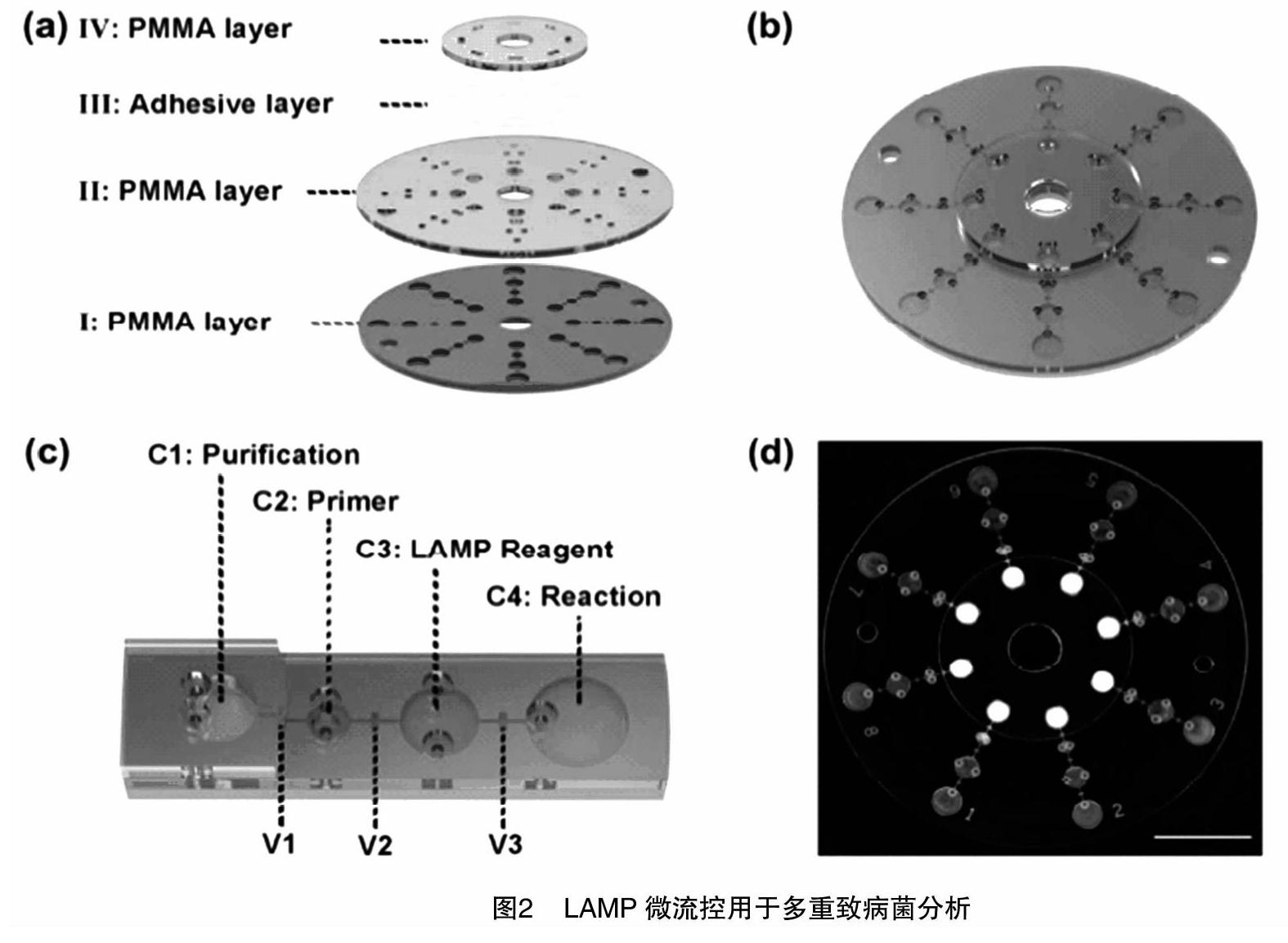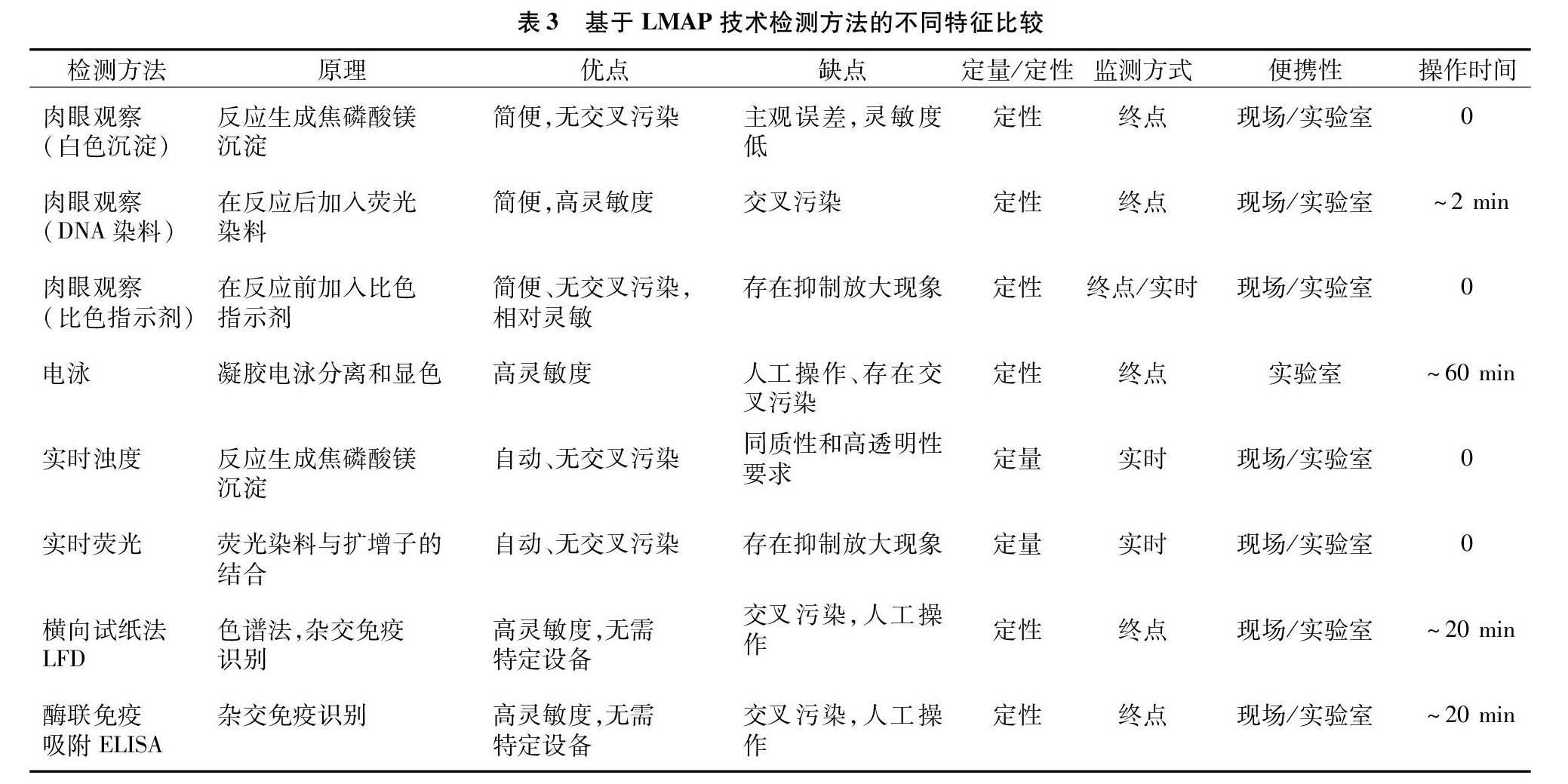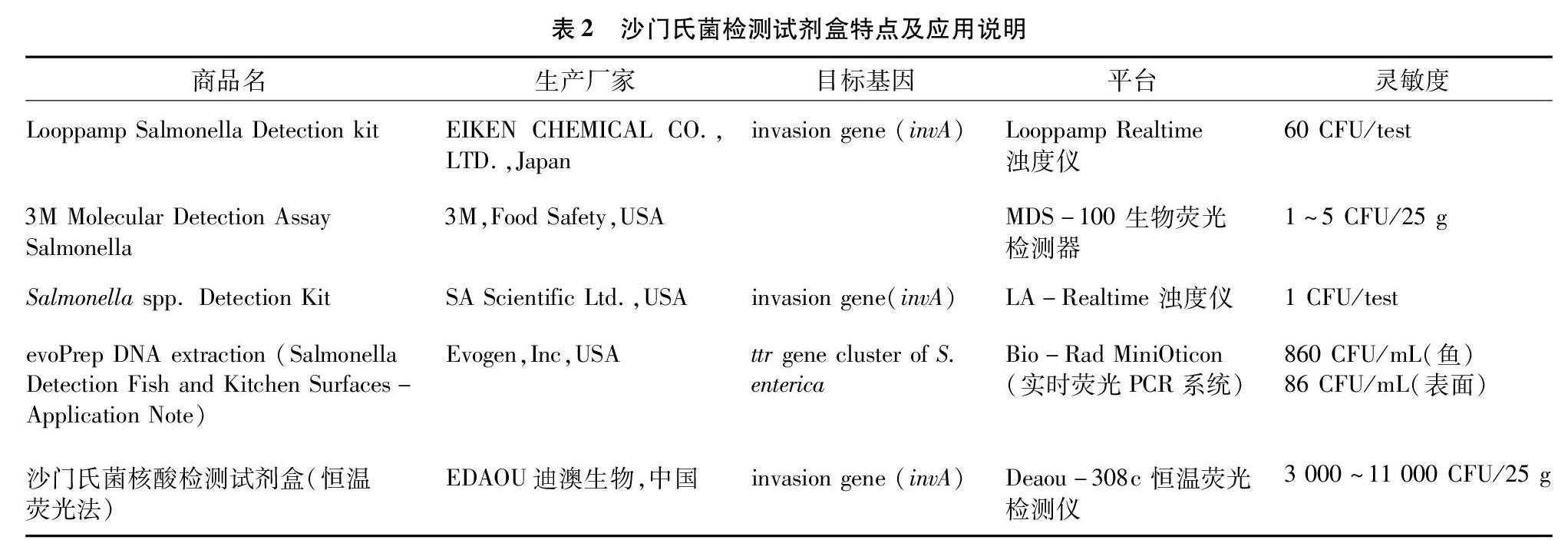環介導等溫擴增技術在食源性沙門氏菌檢測中的應用研究進展
魏楨元



摘要:沙門氏菌是世界上最常見的食源性致病菌之一,全球每年沙門氏菌中毒事件居細菌性中毒事件首位。環介導等溫擴增技術(loop-mediated isothermal amplification,LAMP)是一種新型的核酸恒溫擴增方法。2005年首次報道了采用LAMP技術快速檢測沙門氏菌的研究,在隨后的十幾年中,LAMP技術不斷優化完善,并廣泛應用于食品沙門氏菌的現場檢測。本綜述闡述LAMP的技術原理和特點,歸納基于LAMP技術的不同平臺在沙門氏菌快速檢測中的應用,同時對LAMP技術假陽性率高的問題進行了探討,并對LAMP技術的發展方向和研究趨勢提出了幾個設想。
關鍵詞:環介導等溫擴增技術;沙門氏菌;食源性致病菌;現場檢測;研究進展
中圖分類號:TS207.4 ?文獻標志碼:A ?文章編號:1002-1302(2020)03-0080-06
沙門氏菌是需氧或兼性厭氧的革蘭氏陰性菌,屬于腸桿菌科。非傷寒沙門氏菌對人體健康的影響很大。據WHO食源性疾病監控計劃統計,非傷寒沙門氏菌導致9 380萬人感染,其中通過食源性導致8 030萬人感染,每年有15.5萬人因此而喪生[1]。沙門氏菌感染對全球造成巨大的經濟損失和負擔。在2010年美國由沙門氏菌感染導致的醫療成本、人員工資損失、過早死亡的成本高達27億美元,這并不包括相關產品召回、疾病防控以及不可估量的相關生產廠商及農產品的商譽損失[2]。在中國,70%~80%細菌性食源性疾病是由沙門氏菌感染引起的,其中90%的食物是肉、奶、蛋等畜產品[3]。已經鑒定出的腸炎沙門氏菌血清型超過 2 500 種,但大多數人體感染是由有限數量的血清型引起的[4]。腸炎沙門氏菌是最常見沙門氏菌菌株之一,通常與雞蛋、家禽及其產品的沙門氏菌病的爆發有關[5]。在2016年全球食品致病菌測試量達到2.8億份,市場價值超過180億美元。其中,測試量排名第一的致病菌是沙門氏菌,占檢測量的43%[6]。
迄今為止,細菌檢測或鑒定主要基于培養的方法[7]。沙門氏菌的傳統檢測方法(ISO 6579:2002《食品和動物飼料微生物學 沙門氏菌檢測》,GB 4789.4—2016《食品微生物學檢驗 沙門氏菌檢驗》)包括前增菌、選擇性增菌、菌落形態觀察、生化和血清分型鑒定。傳統方法雖然可靠,但是人工操作繁瑣,需要幾天時間才能確定結果,無法滿足食品安全控制的要求[8-10]。建立公共健康和食品行業快速、靈敏、專一的沙門氏菌檢測方法是非常必要的[11]。致病菌快速篩選和檢測方法已經被開發和驗證。由于特異性低,用于檢測沙門氏菌的酶聯免疫法(ELISA)的應用受到限制[12]。此外,免疫學快速篩選法需要大量目標病原體[13]。
近些年來,利用PCR、real-time PCR和基因芯片在食源性致病菌檢測上的應用已非常廣泛[14-16]。基于分子學方法設計沙門氏菌的目標基因包括invA、fimC、ttrRSBCA、phoP等。大部分的分子學方法已經能夠把檢測時間縮短到3 d以內[10],但是PCR方法仍然需要額外的樣品前處理去消除擴增抑制。此外,PCR方法對化合物中存在的污染和抑制非常敏感,同時,需要凝膠電泳和擴展測序或建立real-time PCR體系來完成檢測[17]。因此,需要建立有效和穩定的食源性致病菌快速篩選方法以控制由沙門氏菌造成的風險。環介導等溫擴增技術是一種新型的核酸擴增技術,目前已經成為各種細菌、真菌、寄生蟲、病毒快速檢測手段中PCR方法的“替代者”[18-19]。在2005年,Hara-Kudo 發表了首篇LAMP技術在沙門氏菌檢測中的應用[20]。此后,LAMP沙門氏菌檢測技術的研究不斷發展,并廣泛應用于人類食品和動物飼料領域。該篇綜述的目的是闡述LAMP的技術原理和特點,歸納LAMP技術在食品中沙門氏菌檢測中的研究進展,并對LAMP技術的發展方向和研究趨勢提出了幾個設想。
1 LAMP技術概況
環介導等溫擴增(loop-mediated isothermal amplification,LAMP)技術是一種由Notomi等在2000年率先建立的新型核酸體外擴增技術[21],與其他快速檢測方法相比,LAMP具有特異性強、靈敏度高、操作簡單、成本低等優點,并成為在食源性致病菌快速診斷中具有潛在價值的工具[22]。
1.1 技術原理
LAMP 技術的原理是以目標基因的特異區域設計引物(圖1),用2條內引物FIP(forward inner primer)和2條外引物BIP(backward inner primer)分別識別目標基因的6個特定區域(3′端的F3c、F2c、Flc,5′端的B1、B2、B3)。然后利用Bst DNA聚合酶在恒溫條件下參與反應以完成目的基因的擴增[23]。 LAMP技術的擴增反應體系包括Bst DNA聚合酶、緩沖液dNTPs等;反應過程由反應原料積累、循環擴展、自動延伸和循環3個階段構成;基本步驟是在該體系下60~65 ℃恒溫反應60 min,由于聚合酶在80 ℃以上的溫度下會失去活力,因此在此條件下加熱2 min終止反應[24]。在優化LAMP技術的過程中,Nagamine 等通過加入2條環引物以加快目標基因的擴增速度,添加環引物的LAMP比傳統方法的反應時間大幅縮短,提高了擴增效率[25]。
1.2 技術特點
(1)特異性強。PCR只需要2條引物識別靶基因的2個特異區域,而LAMP擴增技術需要設計4條引物與目標基因的6個特異區域匹配才能進行擴增反應。
(2)靈敏度高。LAMP技術能檢測到109的拷貝數,檢測靈敏度高于傳統PCR技術。李雪等比較了加環引物LAMP法、LMAP法和PCR法測定沙門氏菌的靈敏度,結果顯示加環引物的LAMP法的靈敏度為2.28 CFU/mL,高于PCR法3個數量級[26]。
參考文獻:
[1]The community summary report on trends and sources of zoonoses,zoonotic agents,antimicrobial resistance and foodborne outbreaks in the European Union in 2005[J]. The EFSA Journal,2006,94:1-352.
[2]Jenkins D M,Kubota R,Dong J,et al. Handheld device for real-time,quantitative,LAMP-based detection of Salmonella enterica using assimilating probes [J]. Biosensors & Bioelectronics,2011,30(1):255-260.
[3]Zeng X F. Inspection and control of Salmonella pollution in domestic animal products [J]. Sichuan Animal and Veterinary Sciences,2003,30(4):28-29.
[4]Hendriksen R S,Vieira A R,Karlsmose S,et al. Global monitoring of Salmonella serovar distribution from the World Health Organization global foodborne infections network country data bank:results of quality assured laboratories from 2001 to 2007[J]. Foodborne Pathogens and Disease,2011,8(8):887-900.
[5]Ohtsuki R,Kawamoto K,Kato Y,et al. Rapid detection of Brucella spp. by the loop-mediated isothermal amplification method[J]. Journal of Applied Microbiology,2008,104(6):1815-1823.
[6]Ferguson B. A look at the microbiology testing market [J]. Food Safety Magazine 2017:14-15.
[7]Francois P,Tangomo M,Hibbs J,et al. Robustness of a loop-mediated isothermal amplification reaction for diagnostic applications[J]. FEMS Immunology and Medical Microbiology,2011,62(1):41-48.
[8]Wang L,Shi L,Alam M J,et al. Specific and rapid detection of foodborne Salmonella by loop-mediated isothermal amplification method[J]. Food Research International,2008,41(1):69-74.
[9]Yang J L,Ma G P,Yang R et al. Simple and rapid detection of Salmonella serovar enteritidis under field conditions by loop-mediated isothermal amplification[J]. Journal of Applied Microbiology,2010,109(5):1715-1723.
[10]Zhang G D,Brown E W,González Escalona N. Comparison of real-time PCR,reverse transcriptase real-time PCR,loop-mediated isothermal amplification,and the FDA conventional microbiological method for the detection of Salmonella spp. in produce [J]. Applied and Environmental Microbiology,2011,77(18):6495-6501.
[11]Ueda S,Kuwabara Y. The rapid detection of Salmonella from food samples by loop-mediated isothermal amplification (LAMP) [J]. Biocontrol Science,2009,14(2):73-76.
[12]Chen S,Wang F,Beaulieu JC,et al. Rapid detection of viable salmonellae in produce by coupling propidium monoazide with loop-mediated isothermal amplification[J]. Applied and Environmental Microbiology,2011,77(12):4008-4016.
[13]Lee K,Iwata T,Shimizu M,et al. A novel multiplex PCR assay for Salmonella subspecies identification [J]. Journal of Applied Microbiology,2009,107(3):805-811.
[14]Elizaquivel P,Aznar R. A multiplex RTi-PCR reaction for simultaneous detection of Escherichia coli O157 ∶ H7,Salmonella spp. and Staphylococcus aureus on fresh,minimally processed vegetables [J]. Food Microbiology,2008,25(5):705-713.
[15]Oliveira S D,Santos L R,Schuch D M T,et al. Detection and identification of salmonellas from poultry related samples by PCR [J]. Veterinary Microbiology,2002,87(1):25-35.
[16]Naravaneni R,Jamil K. Rapid detection of food-borne pathogens by using molecular techniques [J]. Journal of Medical Microbiology,2005,54(1):51-54.
[17]Kothary M H,Babu U S. Infective dose of foodborne pathogens in volunteers:a review[J]. Journal of Food Safety,2001,21(1):49-73.
[18]Niessen L,Luo J,Denschlag C,et al. The application of loop-mediated isothermal amplification (LAMP) in food testing for bacterial pathogens and fungal contaminants [J]. Food Microbiology 2013;36(2):191-206.
[19]Li Y M,Fan P H,Zhou S S,et al. Loop-mediated isothermal amplification (LAMP):a novel rapid detection platform for pathogens [J]. Microbial Pathogensis 2017;107(6):54-61.
[20]Hara-Kudo Y,Yoshino M,Kojima T. et al. Loop-mediated isothermal amplification for the rapid detection of Salmonella [J]. FEMS Microbiology Letters 2005,253(1):155-161.
[21]Notomi T,Okayama H,Masubuchi H,et al. Loop-mediated isothermal amplification of DNA[J]. Nucleic Acids Research,2000,28(12):E63.
[22]Shao Y,Zhu S,Jin C,et al. Development of multiplex loop-mediated isothermal amplification-RFLP (mLAMP-RFLP) to detect Salmonella spp. and Shigella spp. in milk[J]. International Journal of Food Microbiology,2011,148(2):75-79.
[23]Mori Y,Kanda H,Notomi T. Loop-mediated isothermal amplification (LAMP):recent progress in research and development [J]. Journal of Infection and Chemotherapy,2013,19(3):404-411.
[24]Li S G,Luo Y P,Kuang Y Y. Loop-mediated isothermal amplification method for detection of nucleic acids and its application[J]. Microbiology China,2007,34(3):557-560.
[25]Nagamine K,Hase T,Notomi T. Accelerated reaction by loop-mediated isothermal amplification using loop primers [J]. Molecular and Cellular Probes,2002,16(3):223-229.
[26]Li X,Tang S H,Hao X Q,et al. Lamp with added primers for rapid detection of Salmonella [J]. Journal of Southwest University for Nationalities,2011,38(1):64-88.
[27]Xin L,Cui Y,Zhang L W. Advance of loop-mediated isothermal amplification application in rapid detecting food-borne pathogenic microorganism[J]. Chinese Institute of Food Science and Technology. 2018,18(3):212-220.
[28]Zhang X Z,Lowe S B,Gooding J J. Brief review of monitoring methods for loop-mediated isothermal amplification (LAMP)[J]. Biosensors & Bioelectronics 2014,61:491-499.
[29]Le T H,Nguyen N T,Truong N H,et al. Development of mitochondrial loop-mediated isothermal amplification for detection of the small liver fluke Opisthorchis viverrini (Opisthorchiidae;Trematoda;Platyhelminthes) [J]. Journal of Clinical Microbiology 2012,50(4):1178-1184.
[30]Tomita N,Mori Y,Kanda H,et al. Loop-mediated isothermal amplification (LAMP) of gene sequences and simple visual detection of products[J]. Nature Protocols 2008,3(5):877-882.
[31]Kokkinos P A,Ziros P G,Bellou M,et al. Loop-mediated isothermal amplification (LAMP) for the detection of Salmonella in food [J]. Food Analytical Methods,2014,7(2):512-526.
[32]Karanth P A,Anirban C,Iddya K,et al. Loop-mediated isothermal amplification assay as a point-of-care diagnostic tool for Vibrio parahaemolyticus:recent developments and improvements [J]. Expert Review of Molecular Diagnostics,2019,19(3) 229-239.
[33]Ravan H,Yazdanparast R. Development and evaluation of a loop-mediated isothermal amplification method in conjunction with an enzyme-linked immunosorbent assay for specific detection of Salmonella serogroup D[J].Analytica Chimica Acta,2012,733(6):64-79.
[34]Draz M S,Lu X. Development of a loop mediated isothermal amplification (LAMP)-surface enhanced raman spectroscopy (SERS) assay for the detection of Salmonella enterica serotype enteritidis [J]. Theranostics,2016,6(4):522-532.
[35]Zhao Y,Jiang X,Qu Y,et al. Salmonella detection in powdered dairy products using a novel molecular tool [J]. Journal of Dairy Science,2017,100(5):3480-3496.
[36]Zhang L,Tian F,Liu C,et al. Hand-powered centrifugal microfluidic platform inspired by the spinning top for sample-to-answer diagnostics of nucleic acids[J]. Lab On A Chip,2018,18(4):610-619.
[37]Liang Y L,Liu X,Zhou Z S et al. Detection of Salmonella by reverse transcriptase loop-mediated isothermal amplification [J]. Microbiology China,2018,45(10),2293-2300.

